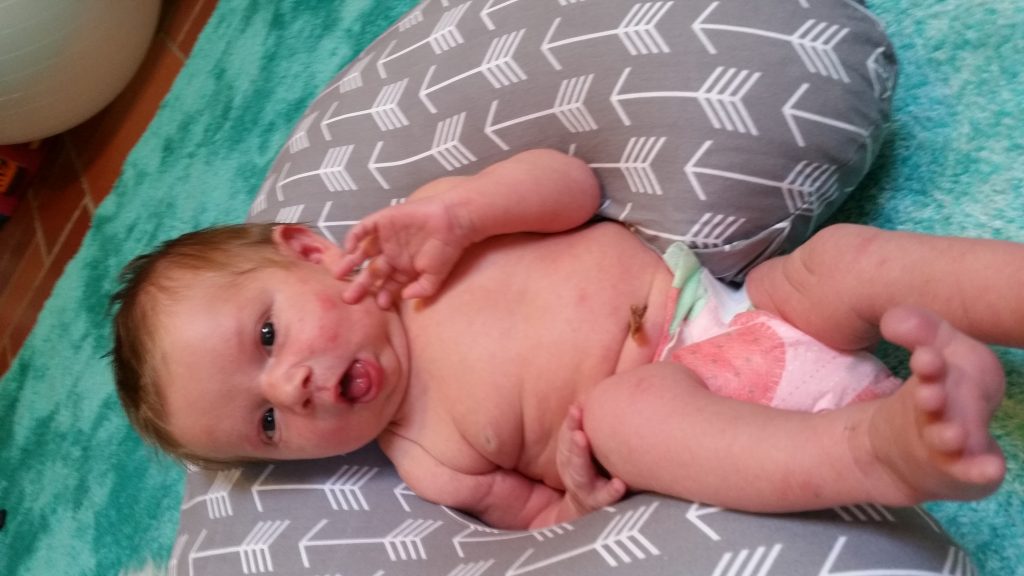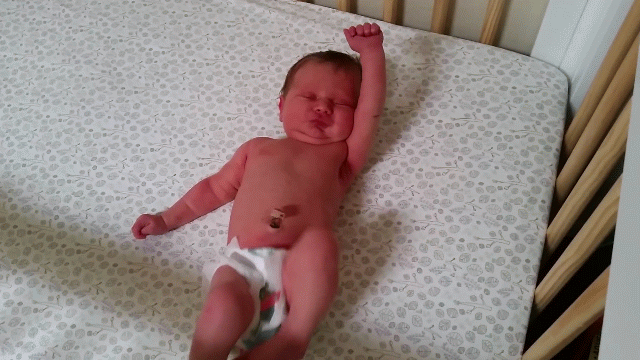Have you noticed how often a baby twitches in his or her sleep, or waves, wiggles and squirms about while awake, including tongue fasciculations? Is all this movement necessary? What can the science of sensorimotor development tell us about these phenomena? Here are 7 reasons why a newborn baby twitches and moves every little and big part of their body.
[1] Let’s look at the sleeping infant first. When a baby sleeps, if they are developing typically, you will observe them profusely twitching. Professor Mark S. Blumberg has been studying such twitches, called “myoclonic” twitches, for two decades. As he puts it, there are “intriguing relationships between twitching and the skills that babies are developing.”
Blumberg et. al have recently found the neural mechanisms that are behind this activity, and that send sensory feedback from the moving limbs to the spine and brain. As this dynamic development occurs, a foundational neural network experiences self-organization. At first, signals between the baby’s brain and muscles are somewhat helter-skelter. Producing functional communication between the two takes adequate input and may, in some instances, be problematic. In conclusion, Blumberg’s research has found that twitches are used by the body during active sleep to “establish, refine, maintain, and repair sensorimotor circuits at multiple levels of the nervous system.”
[2] As this sensorimotor system slowly matures, the mental processes of knowing and understanding through the senses and experiences and, eventually, thinking–what is referred to as “cognition”–also becomes more robust. Mijna Hadders-Algra’s researches these interrelations and concludes “cognitive drive facilitates the exploration of motor possibilities, and the resulting motor behavior generates sensory and cognitive information.”
[3] Even before they can point to things, infants will use gestures to communicate. Researchers at Max Planck Institute in the Netherlands found that 8-month-old-babies gesture toward an an out of reach object, if a person is nearby and able to help them get it. They didn’t reach out when a caregiver or stranger was absent. This demonstrates developing skills in social understanding and communication. What occurs is an interdependent feedback loop as sensory, motor, and cognitive abilities develop.

[4] Other research has pointed to the importance of vision and our senses of touch and proprioception (our ability to sense our body’s position, motion, and equilibrium) to locate objects. A. J. Bremner argues that “multisensory body representations are involved in all of our mental processes.” He goes on to explain that between 6 and 12 months of age, visual experience is key to the typical development of outward spatial coding of touch. A baby can witness a touch and feel a touch and decipher the difference. This crossmodal ability is crucial to accurately represent touch spatially, blindness early in life interrupts this competency. Individuals with autism spectrum disorder (ASD) have been found to have a similar deficit. In addition, Cascio CJ, et. al found reduction, “in the way visual, tactile, and proprioceptive cues are weighted in multisensory representations of hand position.”
[5] On the influence of the developing motor system on language acquisition let’s examine sensorimotor influences on speech perception in infancy. Bruderer et. al report “striking evidence” that even before a baby can speak, indeed, even before they have much listening experience, they’re receiving information from their lips and tongues that influences speech perception. In their words: “oral–motor movements influence speech sound dis-crimination.” This drew them to the conclusion that interference with such movements may impair speech perception performance. This research has led some to warn of the overuse of, or dependency on, pacifiers.
[6] How we move influences our baby’s musical rhythm perception. Jessica Phillips-Silver and Laurel J. Trainor tested seven month-old infants at their baby lab at McMaster University in Canada and discovered: if you dance a waltz rather than a jig, your baby will prefer the waltz. They also explain that it is the movement of the head and activating of the vestibular system, more than the limbs, that cause metrical encoding to take place. Moreover, the latest research coming from her lab found evidence on the influence of music and language acquisition. Studies found that an infant has the capacity to “entrain” or match and remember incoming auditory rhythms. Young babies exposed to music training have been observed to distinguish two main beats in rhythm patterns. Older infants with similar exposure experienced “non-specific enhancement”. L. Cirelli concluded that musical experiences… “especially in early months of infancy, shape auditory processing in general and temporal processing in particular.” In previous studies by her lab point to social emotional learning and sensorimotor integration in infancy. Trainor found that if you dance with your baby in sync to music, the baby will most likely show a tendency for pro-social behavior.
[7] Lastly, see how a rocking, dancing motion & the proper baby carriage immediately soothes newborn after receiving shots. Dr. Robert Hamilton, who practices at Pacific Ocean Pediatrics in Santa Monica, California developed a specific method, watch as he demonstrates the technique in this video: http://on.today.com/1XCoOhZ
REFERENCES:
Mark S. Blumberg, Hugo Gravato Marques, Fumiya Iida (2013), Twitching in Sensorimotor Development from Sleeping Rats to Robots. Current Biology, Volume 23, Issue 12, 17 June 2013, Pages R532–R537. http://dx.doi.org/10.1016/j.cub.2013.04.075 Online at: http://bit.ly/2dAfGJA
See also: What’s Going On When Babies Twitch in Their Sleep?NEUROSCIENCE NEWS JULY 26, 2016 Online http://bit.ly/2crgEFL
Hadders-Algra, M. (2016), Inspiring Infancy: interrelations between sensory, motor, and cognitive abilities during typical and atypical development. Dev Med Child Neurol, 58: 1–2. doi:10.1111/dmcn.13038
Verónica C. Ramenzoni, Ulf Liszkowski. (2016) The Social Reach: 8-Month-Olds Reach for Unobtainable Objects in the Presence of Another Person. Psychological Science. vol. 27 no. 9 1278-1285. doi: 10.1177/0956797616659938 Online at: http://pss.sagepub.com/content/27/9/1278
Bremner, A. J. (2016), Developing body representations in early life: combining somatosensation and vision to perceive the interface between the body and the world. Dev Med Child Neurol, 58: 12–16.
Cascio CJ, Foss-Feig JH, Burnette CP, Heacock JL, Cosby AA. The rubber hand illusion in children with autism spectrum disorders: delayed influence of combined tactile and visual input on proprioception. Autism 2012; 16: 406–19.
Cirelli, L. K., Spinelli, C., Nozaradan, S., & Trainor, L. J. (2016). Measuring Neural Entrainment to Beat and Meter in Infants: Effects of Music Background. Frontiers in Neuroscience, 10, 229. http://doi.org/10.3389/fnins.2016.0022
Bruderer, A.G., Danielson, D.K., Kandhadai, P., & Werker, J.F. (2015). Sensorimotor influences on speech perception in infancy. Proceedings of the National Academy of Sciences, 112(44), 13531-13536.
